This article has multiple issues. Please help improve it or discuss these issues on the talk page . (Learn how and when to remove these template messages)
|

CAV or Combat Assault Vehicle is a miniatures wargame by Reaper Miniatures.
This article has multiple issues. Please help improve it or discuss these issues on the talk page . (Learn how and when to remove these template messages)
|

CAV or Combat Assault Vehicle is a miniatures wargame by Reaper Miniatures.
Combat Assault Vehicle is named after the 30-foot-tall (9.1 m) war machines that walk the battlefields of the galaxy.
The date is 2274 and the fragile peace the galaxy has known for the last 11 years has been shattered. The second Galaxy War has started and every galactic government is looking out for number one, damn the rest of the galaxy. Fueled by a decade of clandestine wars, secret agendas and unprecedented military preparation, the racial, religious and nationalistic governments across the galaxy have begun grabbing resources, nationalizing UCORs and Mercenaries and folding everything into vast war machines capable of intergalactic domination and destruction.
Past the point of return, it is now the time of reckoning for the galaxy, and if you hope to survive this conflict you must choose a side.
CAV combat and movement rules use the Reaper Adventure Game Engine (R.A.G.E.), a generic game system developed by Reaper for use with their miniatures wargames such as CAV and Warlord. [1] This allows players to switch from game to game without having to learn a new combat and movement system for each game.
CAV models are all cast in N-Scale by Reaper Miniatures. Currently, there are around 100 different models available for the game, with prices starting around $8.00(US) and reaching $25.00(US). [2]
The models cover the wide array of units available in the game, ranging from the namesake CAVs to aircraft, infantry, fighting vehicles, tanks, armored personnel carriers, support models and weapons packs.
When CAV was first released, all the aircraft and APC models were cast in 2/3 N-Scale to make them more affordable for customers. Thanks to numerous requests from the CAV community, Reaper has changed this practice and has begun to re-cast all aircraft and APC models in true N-Scale as of mid-2005. These new "true scale" models carry a different SKU from the old models, so gamers on a budget can still purchase the smaller, less expensive models. The old models are still legal for all CAV events.

Each model in the game has a set of ratings that dictate how well it performs in the game. These ratings are listed on a Data Card, which is an easy to read record sheet. CAV 2 Data Cards are the size of a standard playing card. All CAV Data Cards are available for free download from.
A key component of CAV, and all R.A.G.E. games, is the Damage Track. Each row of stats on the Data Card represents a Damage Track, or the total points of damage that the model can sustain before being destroyed and removed from play. When undamaged, you use all of the stats listed across the 0 Dmg row. If your model takes 2 points of damage, you use the stats on the 2 Dmg row. If your model has more points of damage than it has rows in the Dmg column, its destroyed.

When planning a game of CAV, the first thing that you must decide on is the Game Size. The Game Size is the number of points that each player will be allowed to spend on models for his army. Each model has its own corresponding Point Value. After choosing the models that you want to use for your Task Force, you total up their Point Values to determine your Army Size. Your Army Size must be equal to or less than the Game Size for it to be legal.
A Task Force is composed of several smaller groups of models called Sections. Each Section is made up of a number of models based on its type. Sections are separated into two categories: Primary and Secondary. No Task Force may have more Secondary Sections than it has Primary ones.
The different Section types are outlined below:
Primary Sections
Secondary Sections
[3] CAV games are usually played on either a 4’x6’ or 4’x8’ area. 4’x4' areas are also acceptable for games 2,000 points or smaller. Each Task Force will have its own Deployment Zone; this is the area where all of a player's models begin the game. Each player's Deployment Zone is usually as far away from the other players’ as possible. In a game with two sides, this usually means opposite sides of the table. If there are multiple players or sides involved, the Zones are usually equally spread out around the table.
To determine when each player gets to take a turn, CAV utilizes an Initiative Deck. Using a standard set of playing cards, each player is assigned a color, suit or number, depending on the number of players involved. They are then given 1 card for each Section that they have in their Task Force. These cards are all combined to create the Initiative Deck, which now has one card for each Section in the game. The Initiative Deck is shuffled and the first card turned over. The player who “owns” that card gets to select one of his Sections to Activate.
When a Section is Activated, each model in the Section gets to perform two Actions. Actions come in two varieties: Repeatable and Non-Repeatable. Non-Repeatable Actions cover things like firing a model's weapons, performing special actions, initiating close combat or using a models electronics (ECM/Targeting). Each model may only perform a Non-Repeatable action once per turn. Repeatable Actions consist of things like moving, loading or unloading infantry from a transport and a model attempting to repair itself. Each model may perform the same Repeatable Action twice in the same turn.
The two basic mechanics of the game are Movement and Ranged Combat. Each model has a Mov rating on its Data Card that is the number of inches it can move when performing a Movement Action. So a model with a Mov of 12 could move up to 12” during its turn. Since Movement is a Repeatable Action, the model could perform two Movement Actions during its turn and move up to 24”. However a model's movement may be slightly altered by terrain on the battlefield. Items such as rough terrain, water, trees and hills can hinder a model, forcing it to pay additional movement costs.
Ranged Combat deals with four primary stats in CAV: # of Attacks (#DA or #IA), Ranged Attack Value (RAV), Range (Rng) and Defensive Value (DV). First off, there are two different types of Ranged Attacks: Direct Attacks (DA) and Indirect Attacks (IA). Direct Attacks may only be performed in there is an un-interrupted Line Of Sight between the acting model and its target. Indirect Attacks may be performed against any target, regardless of Line Of Sight. All weapon systems in CAV are designated as either DA or IA and may only be used to perform those types of attacks.
The basics of resolving an attack are:
CAV also has a mechanic for Critical Hits, which can inflict multiple points of damage.
After all of the models in the active Section have performed their attacks, any enemy models that were attacked get a chance to perform Defensive Fire. The Defensive Fire mechanic represents the level of automation and advanced technology that exists in the CAV game world. Each time a model is attacked, its on-board computer automatically retaliates by firing back at its attacker. In game terms, when a model is the target of one or more Ranged Attacks during an enemy Section's Activation phase, it gets to perform one Defensive Shot. The player who controls the targeted model gets to choose one of the attacking models to be the target of his Defensive Shot. The model may only perform one Defensive Shot per Activation, regardless of how many models attacked it or how many Ranged Attacks were performed against it. However Defensive Fire is triggered by the simple act of declaring a Ranged Attack against a model, so even if the attacks do no damage, the target model still gets to perform his Defensive Shot.
If any models ever sustain more points of damage than they have Damage Tracks, they are destroyed. Destroyed models may be replaced with counters to represent their location or simply laid on their side.
Once all of the models in the active Section are finished with their Actions, their turn is over. The next card in the Initiative Deck is turned over and the “owner” of the next card gets to activate one of his Sections. When all of the cards in the deck have been flipped over, the current Turn is over. If any Sections were removed from the game by either being totally destroyed or by Regrouping with another partially destroyed Section, those Sections' cards are removed from the Initiative Deck. The ratio of Initiative Cards to Sections should always be 1:1 at the beginning of a turn.

The Yu-Gi-Oh! Trading Card Game is a collectible card game developed and published by Konami. It is based on the fictional game of Duel Monsters created by manga artist Kazuki Takahashi, which appears in portions of the manga franchise Yu-Gi-Oh! and is the central plot device throughout its various anime adaptations and spinoff series.

Warmachine is a tabletop steampunk wargame originally produced by Privateer Press but currently under the ownership of Steamforged Games.
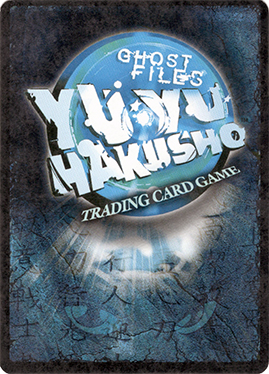
The Yu Yu Hakusho Trading Card Game was first published in 2003 by Score Entertainment, and is based on the anime and manga series YuYu Hakusho. It is a two-player tournament-styled collectible card game; each player uses a deck of forty-four or more cards that is headed by a team of four character cards. The game was discontinued in 2005.

7th Sea is a collectible card game (CCG) first designed by Dan Verssen and published by Alderac Entertainment Group (AEG) in 1999.
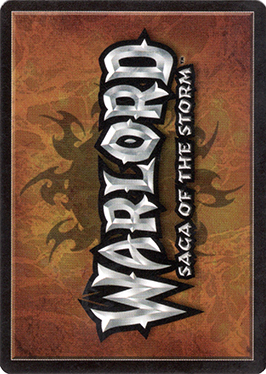
Warlord: Saga of the Storm is a collectible card game designed by Kevin Millard and David Williams. It was produced by Alderac Entertainment Group since its introduction in April 2001 until January 2008, when they announced they were ceasing its production. In place of AEG, German company Phoenix Interactive has licensed the rights to produce the game and printed their first set, Fourth Edition, in July 2008. The longer official name is almost always shortened to Warlord and the subtitle "Saga of the Storm" is often used informally to refer to the original base set of cards. The game is unrelated to an earlier, similarly named CCG, Warlords.

Greyhawk Wars is a fantasy board wargame that was published by TSR, Inc. in 1991. The game was designed by David Cook as a strategic simulation of the eponymous Greyhawk Wars on the fictional world of Oerth, the World of Greyhawk campaign setting for the Dungeons & Dragons role-playing game.
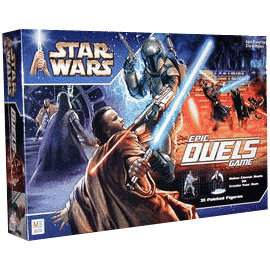
The Star Wars Epic Duels board game was released by Hasbro in 2002. It was designed for ages 8 and up, and for 2-6 players. The main designer of the game was Craig Van Ness, with assistance from Rob Daviau. It is out of print.
The Universal Fighting System (UFS), rebranded as UniVersus in 2021, is a collectible card game published by UVS Games. Games of UFS represent a fight between two characters in hand-to-hand combat. Characters are drawn from original properties as well as a number of licensed ones, such as Mega Man, Street Fighter, The King of Fighters XIII and Darkstalkers. The sets are cross-compatible – cards from multiple licenses can be included in the same deck, and characters from different universes may face each other in a match.

Ultimate Combat! is an out-of-print collectible card game designed around the concept of Asian martial arts combat. The game was designed by judo sensei Dave Long and released in 1995 by Ultimate Games. It is very similar to Magic: The Gathering and roughly 75% of the rules are the same. It was endorsed by the United States Judo Association team, the USA Taekwondo team and the USA Wrestling team.

The City of Heroes Collectible Card Game is an out-of-print trading card game based on the discontinued NCSoft MMORPG, City of Heroes. The card game was designed by David Williams, the designer responsible for other games such as Legend of the Five Rings. The initial product release from Alderac Entertainment Group was in January 2006. The City of Heroes CCG was discontinued in February 2007 as it "did not reach critical mass" according to AEG CEO John Zinser.

Battle Hunter, known in Japan as Battle Sugoroku: Hunter and in Europe as The Hunter, is an anime-styled tactical role-playing game, released for the PlayStation in 1999. It was released in Japan as part of the SuperLite 1500 series of budget games. The game revolves around a player-controlled hunter that must compete with three other hunters in order to win a relic, and makes heavy use of traditional RPG conventions such as dice and tile-based movement.

Wings of War, by Andrea Angiolino and Pier Giorgio Paglia, is a modular boardgame collection published by Nexus Editrice and dedicated to air combat. A new edition is published by Ares Games as Wings of Glory.

The Bleach Trading Card Game is an out-of-print collectible card game from Score Entertainment, and is based on the manga and anime series of the same name. The game received a nomination for Origin's "Game of the Year" and earned a semi-finalist position.
Star Wars PocketModel Trading Card Game is an out-of-print tabletop game manufactured by WizKids, Inc. that debuted in 2007, based on the Star Wars universe. The game was designed by Mike Elliott and Ethan Pasternack.
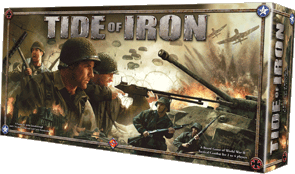
Tide of Iron is a World War II based wargame designed and published in 2007 by Fantasy Flight Games, also notable for publishing other large games containing a large number of counters and/or other components such as World of Warcraft: The Board Game and Arkham Horror.
The rules of Magic: The Gathering were originally developed by the game's creator, Richard Garfield, and accompanied the first version of the game in 1993. The rules of Magic have been changed frequently over the years by the manufacturer, Wizards of the Coast, mostly in minor ways. However, major rules overhauls have also been done a few times.

Shadow Hunters is a social deduction board game designed by Yasutaka Ikeda that was first published in 2005 by Game Republic in Japan. The game was published in the United States by Z-Man Games in 2008. The art style of the game closely resembles the style found in Japanese anime and manga.
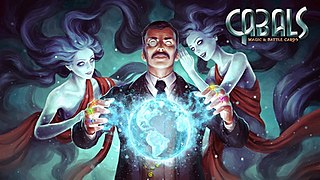
Cabals: Magic & Battle Cards is a digital collectible card game designed by Mika Rosendahl and developed by Finnish studio Kyy Games. The game combines a board mechanic and cross-platform online multiplayer gameplay. Cabals: The Card Game was published on November 30, 2011, for iPhone, iPad, Android and Internet Browsers. The newly named Cabals: Magic & Battle Cards was released on April 11, 2014.
Star Wars: X-Wing Second Edition is the second edition of the miniature war game designed by Jay Little and produced by Fantasy Flight Games that was first announced on May 1, 2018, with the first release on September 13 of the same year. On November 16, 2020, Atomic Mass Games announced that it would be responsible for X-wing and its two sister games, Legion and Armada.